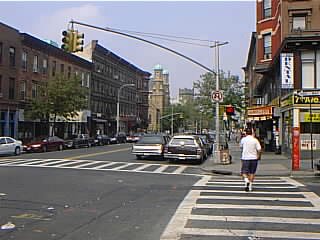
7th avenue, looking north from about 8th street
Physical Design
Park Slope, as its name would suggest, is built on a gently sloping hill, with the park at the top. The neighborhood is defined by a grid system of streets, including two main commercial avenues – 5th and 7th – running north-south, and about 20 residential side streets running east-west, with the named and lower numbered streets at the northern end. 7th Avenue has been the traditional commercial strip, with more established shops and restaurants, but recently, 5th Avenue has also become host to a growing number of hip gourmet restaurants, boutiques and bars.
Both the streets and the avenues of the Slope have perfect proportions to accommodate a comfortable walking lifestyle. The avenues – lined with mostly four- and five-story buildings that are built fully out to the sidewalk – features only one lane of traffic in each direction, buffered from the curb by parked cars. The streets are mostly one-way, except for Union and 9th street, which divide the neighborhood into thirds. The street design keeps traffic slow, which makes it comfortable for strolling or outside of a restaurant or cafe to people-watch. The outer edges of the sidewalks on both the streets and the avenues are lined with trees, creating a sense of enclosure when walking on the sidewalk, as if moving through a well-defined shaft of space, with the clear goal of the next corner down the block. A full array of business operate on the avenues, including locally owned pizza joints, “bodega” style groceries, and hardware stores, in addition to the more fashionable restaurants and shops. Because of the centralized commercial strips and the walkable scale, Park Slope is the kind of place where the shoppers and store owners know each other by name, and you always have a good chance of running in to a friend when you’re out and about.
